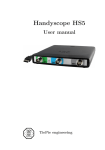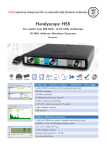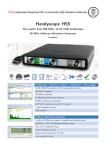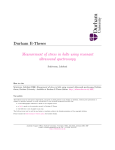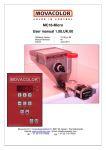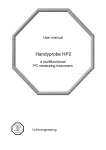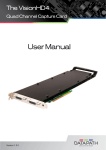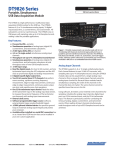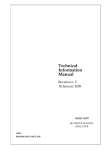Download Manual HS4D - Egmont Instruments
Transcript
Handyscope HS4 DIFF User manual TiePie engineering ATTENTION! Measuring directly on the line voltage can be very dangerous. Copyright c 2014 TiePie engineering. All rights reserved. Revision 2.9, October 2014 Despite the care taken for the compilation of this user manual, TiePie engineering can not be held responsible for any damage resulting from errors that may appear in this manual. Contents 1 Safety 1 2 Declaration of conformity 3 3 Introduction 3.1 Differential input . . . . . . . . 3.1.1 Differential attenuators 3.1.2 Differential test lead . . 3.2 Sampling . . . . . . . . . . . . 3.3 Sample frequency . . . . . . . . 3.3.1 Aliasing . . . . . . . . . 3.4 Digitizing . . . . . . . . . . . . 3.5 Signal coupling . . . . . . . . . . . . . . . . . . . . . . . . . . . . . . . . . . . . . . . . . . . . . . . . . . . . . . . . . . . . . . . . . . . . . . . . . . . . . . . . . . . . . . . . . . . . . . . . . 5 6 7 9 9 10 11 13 13 . . . . . . . . 4 Driver installation 15 4.1 Introduction . . . . . . . . . . . . . . . . . . . . . . . 15 4.2 Where to find the driver setup . . . . . . . . . . . . 15 4.3 Executing the installation utility . . . . . . . . . . . 15 5 Hardware installation 5.1 Power the instrument . . . . . . . . . . 5.1.1 External power . . . . . . . . . . 5.2 Connect the instrument to the computer 5.2.1 Found New Hardware Wizard . . 5.3 Plug into a different USB port . . . . . . . . . . . . . . . . . . . . . . . . . . . . . . . . . . . . . . . . 21 21 21 22 23 25 6 Front panel 27 6.1 Channel input connectors . . . . . . . . . . . . . . . 27 6.2 Power indicator . . . . . . . . . . . . . . . . . . . . . 27 7 Rear panel 7.1 Power . . . . . . . . . . 7.1.1 USB power cable 7.1.2 Power adapter . 7.2 USB . . . . . . . . . . . 7.3 Extension Connector . . . . . . . . . . . . . . . . . . . . . . . . . . . . . . . . . . . . . . . . . . . . . . . . . . . . . . . . . . . . . . . . . . . . . . . . 8 Specifications . . . . . . . . . . 29 29 30 31 31 31 33 Contents I 8.1 8.2 8.3 8.4 8.5 8.6 8.7 8.8 8.9 8.10 8.11 II Acquisition system . . . . . . . BNC inputs CH1 to CH4 . . . Trigger system . . . . . . . . . Interface . . . . . . . . . . . . . Power . . . . . . . . . . . . . . Physical . . . . . . . . . . . . . I/O connectors . . . . . . . . . System requirements . . . . . . Environmental conditions . . . Certifications and Compliances Package contents . . . . . . . . . . . . . . . . . . . . . . . . . . . . . . . . . . . . . . . . . . . . . . . . . . . . . . . . . . . . . . . . . . . . . . . . . . . . . . . . . . . . . . . . . . . . . . . . . . . . . . . . . . . . . . . . . . . . . . . . . . . . . . . . . . . . . . . . . . . . 33 33 34 34 34 34 34 35 35 35 35 Safety 1 When working with electricity, no instrument can guarantee complete safety. It is the responsibility of the person who works with the instrument to operate it in a safe way. Maximum security is achieved by selecting the proper instruments and following safe working procedures. Safe working tips are given below: • Always work according (local) regulations. • Work on installations with voltages higher than 25 VAC or 60 VDC should only be performed by qualified personnel. • Avoid working alone. • Observe all indications on the Handyscope HS4 DIFF before connecting any wiring • Check the probes/test leads for damages. Do not use them if they are damaged • Take care when measuring at voltages higher than 25 VAC or 60 VDC . • Do not operate the equipment in an explosive atmosphere or in the presence of flammable gases or fumes. • Do not use the equipment if it does not operate properly. Have the equipment inspected by qualified service personal. If necessary, return the equipment to TiePie engineering for service and repair to ensure that safety features are maintained. Safety 1 2 Chapter 1 Declaration of conformity 2 TiePie engineering Koperslagersstraat 37 8601 WL Sneek The Netherlands EC Declaration of conformity We declare, on our own responsibility, that the product Handyscope Handyscope Handyscope Handyscope HS4 HS4 HS4 HS4 DIFF-5MHz DIFF-10MHz DIFF-25MHz DIFF-50MHz for which this declaration is valid, is in compliance with EN 55011:2009/A1:2010 EN 55022:2006/A1:2007 IEC 61000-6-1/EN 61000-6-1:2007 IEC 61000-6-1/EN 61000-6-1:2007 according the conditions of the EMC standard 2004/108/EC and also with Canada: ICES-001:2004 Australia/New Zealand: AS/NZS Sneek, 1-11-2010 ir. A.P.W.M. Poelsma Declaration of conformity 3 Environmental considerations This section provides information about the environmental impact of the Handyscope HS4 DIFF. Handyscope HS4 DIFF end-of-life handling Production of the Handyscope HS4 DIFF required the extraction and use of natural resources. The equipment may contain substances that could be harmful to the environment or human health if improperly handled at the Handyscope HS4 DIFF’s end of life. In order to avoid release of such substances into the environment and to reduce the use of natural resources, recycle the Handyscope HS4 DIFF in an appropriate system that will ensure that most of the materials are reused or recycled appropriately. The symbol shown below indicates that the Handyscope HS4 DIFF complies with the European Union’s requirements according to Directive 2002/96/EC on waste electrical and electronic equipment (WEEE). Restriction of Hazardous Substances The Handyscope HS4 DIFF has been classified as Monitoring and Control equipment, and is outside the scope of the 2002/95/EC RoHS Directive. 4 Chapter 2 3 Introduction Before using the Handyscope HS4 DIFF first read chapter 1 about safety. Many technicians investigate electrical signals. Though the measurement may not be electrical, the physical variable is often converted to an electrical signal, with a special transducer. Common transducers are accelerometers, pressure probes, current clamps and temperature probes. The advantages of converting the physical parameters to electrical signals are large, since many instruments for examining electrical signals are available. The Handyscope HS4 DIFF is a portable four channel measuring instrument with differential inputs. The Handyscope HS4 DIFF is available in several models with different maximum sampling frequencies. The native resolution is 12 bits, but user selectable resolutions of 14 and 16 bits are available too, with reduced maximum sampling frequency: resolution Model 50 Model 25 Model 10 Model 5 12 bit 14 bit 16 bit 50 MS/s 3.125 MS/s 25 MS/s 3.125 MS/s 10 MS/s 3.125 MS/s 5 MS/s 3.125 MS/s 195 kS/s 195 kS/s 195 kS/s 195 kS/s Table 3.1: Maximum sampling frequencies The Handyscope HS4 DIFF supports high speed continuous streaming measurements. The maximum streaming rates are: resolution Model 50 Model 25 Model 10 Model 5 12 bit 500 kS/s 250 kS/s 100 kS/s 50 kS/s 14 bit 16 bit 480 kS/s 195 kS/s 250 kS/s 195 kS/s 99 kS/s 97 kS/s 50 kS/s 48 kS/s Table 3.2: Maximum streaming rates Introduction 5 With the accompanying software the Handyscope HS4 DIFF can be used as an oscilloscope, a spectrum analyzer, a true RMS voltmeter or a transient recorder. All instruments measure by sampling the input signals, digitizing the values, process them, save them and display them. 3.1 Differential input Most oscilloscopes are equipped with standard, single ended inputs, which are referenced to ground. This means that one side of the input is always connected to ground and the other side to the point of interest in the circuit under test. Figure 3.1: Single ended input Therefore the voltage that is measured with an oscilloscope with standard, single ended inputs is always measured between that specific point and ground. When the voltage is not referenced to ground, connecting a standard single ended oscilloscope input to the two points would create a short circuit between one of the points and ground, possibly damaging the circuit and the oscilloscope. A safe way would be to measure the voltage at one of the two points, in reference to ground and at the other point, in reference to ground and then calculate the voltage difference between the two points. On most oscilloscopes this can be done by connecting one of the channels to one point and another channel to the other point and then use the math function CH1 - CH2 in the oscilloscope to display the actual voltage difference. There are some disadvantages to this method: • a short circuit to ground can be created when an input is wrongly connected • to measure one signal, two channels are occupied 6 Chapter 3 • by using two channels, the measurement error is increased, the errors made on each channel will be combined, resulting in a larger total measurement error • The Common Mode Rejection Ratio (CMRR) of this method is relatively low. If both points have a relative high voltage, but the voltage difference between the two points is small, the voltage difference can only be measured in a high input range, resulting in a low resolution A much better way is to use an oscilloscope with a differential input. Figure 3.2: Differential input A differential input is not referenced to ground, but both sides of the input are ”floating”. It is therefore possible to connect one side of the input to one point in the circuit and the other side of the input to the other point in the circuit and measure the voltage difference directly. Advantages of a differential input: • No risk of creating a short circuit to ground • Only one channel is required to measure the signal • More accurate measurements, since only one channel introduces a measurement error • The CMRR of a differential input is high. If both points have a relative high voltage, but the voltage difference between the two points is small, the voltage difference can be measured in a low input range, resulting in a high resolution 3.1.1 Differential attenuators To increase the input range of the Handyscope HS4 DIFF, it comes with a differential 1:10 attenuator for each channel. This differenIntroduction 7 tial attenuator is specially designed to be used with the Handyscope HS4 DIFF. Figure 3.3: Differential attenuator For a differential input, both sides of the input need to be attenuated. Figure 3.4: Differential input Standard oscilloscope probes and attenuators only attenuate one side of the signal path. These are not suitable to be used with a differential input. Using these on a differential input will have a negative effect on the CMRR and will introduce measurement errors. Figure 3.5: Differential input 8 Chapter 3 The Differential Attenuator and the inputs of the Handyscope HS4 Diff are differential, which means that the outside of the BNC’s are not grounded, but carry life signals. When using the attenuator, the following points have to be taken into consideration: • do not connect other cables to the attenuator than the ones that are supplied with the instrument • do not touch the metal parts of the BNC’s when the attenuator is connected to the circuit under test, they can carry a dangerous voltage. It will also influence the measurements and create measurement errors. • do not connect the outside of the two BNC’s of the attenuator to each other as this will short circuit a part of the internal circuit and will create measurement errors • do not connect the outside of the BNC’s of two or more attenuators that are connected to different channels of the Handyscope HS4 Diff to each other • do not apply excessive mechanical force to the attenuator in any direction (e.g. pulling the cable, using the attenuator as handle to carry the Handyscope HS4 DIFF, etc.) 3.1.2 Differential test lead The Handyscope HS4 DIFF comes with a special differential test lead. This test lead is specially designed to ensure a good CMRR. The special heat resistant differential test lead provided with the Handyscope HS4 DIFF is designed to be immune for noise from the surrounding environment. 3.2 Sampling When sampling the input signal, samples are taken at fixed intervals. At these intervals, the size of the input signal is converted to a number. The accuracy of this number depends on the resolution of the instrument. The higher the resolution, the smaller the voltage steps in which the input range of the instrument is divided. The acquired numbers can be used for various purposes, e.g. to create a graph. Introduction 9 Figure 3.6: Sampling The sine wave in figure 3.6 is sampled at the dot positions. By connecting the adjacent samples, the original signal can be reconstructed from the samples. You can see the result in figure 3.7. Figure 3.7: ”connecting” the samples 3.3 Sample frequency The rate at which the samples are taken is called the sampling frequency, the number of samples per second. A higher sampling frequency corresponds to a shorter interval between the samples. As is visible in figure 3.8, with a higher sampling frequency, the original signal can be reconstructed much better from the measured samples. 10 Chapter 3 Figure 3.8: The effect of the sampling frequency The sampling frequency must be higher than 2 times the highest frequency in the input signal. This is called the Nyquist frequency. Theoretically it is possible to reconstruct the input signal with more than 2 samples per period. In practice, 10 to 20 samples per period are recommended to be able to examine the signal thoroughly. 3.3.1 Aliasing When sampling an analog signal with a certain sampling frequency, signals appear in the output with frequencies equal to the sum and difference of the signal frequency and multiples of the sampling frequency. For example, when the sampling frequency is 1000 Hz and the signal frequency is 1250 Hz, the following signal frequencies will be present in the output data: Multiple of sampling frequency 1250 Hz signal -1250 Hz signal -1000 -1000 + 1250 = 250 -1000 - 1250 = -2250 0 0 + 1250 = 1250 1000 1000 + 1250 = 2250 1000 - 1250 = -250 2000 2000 + 1250 = 3250 2000 - 1250 = 750 ... 0 - 1250 = -1250 ... Table 3.3: Aliasing As stated before, when sampling a signal, only frequencies lower than half the sampling frequency can be reconstructed. In this case the sampling frequency is 1000 Hz, so we can we only observe Introduction 11 signals with a frequency ranging from 0 to 500 Hz. This means that from the resulting frequencies in the table, we can only see the 250 Hz signal in the sampled data. This signal is called an alias of the original signal. If the sampling frequency is lower than twice the frequency of the input signal, aliasing will occur. The following illustration shows what happens. Figure 3.9: Aliasing In figure 3.9, the green input signal (top) is a triangular signal with a frequency of 1.25 kHz. The signal is sampled with a frequency of 1 kHz. The corresponding sampling interval is 1/1000Hz = 1ms. The positions at which the signal is sampled are depicted with the blue dots. The red dotted signal (bottom) is the result of the reconstruction. The period time of this triangular signal appears to be 4 ms, which corresponds to an apparent frequency (alias) of 250 Hz (1.25 kHz - 1 kHz). To avoid aliasing, always start measuring at the highest sampling frequency and lower the sampling frequency if required. 12 Chapter 3 3.4 Digitizing When digitizing the samples, the voltage at each sample time is converted to a number. This is done by comparing the voltage with a number of levels. The resulting number is the number corresponding to the level that is closest to the voltage. The number of levels is determined by the resolution, according to the following relation: LevelCount = 2Resolution . The higher the resolution, the more levels are available and the more accurate the input signal can be reconstructed. In figure 3.10, the same signal is digitized, using two different amounts of levels: 16 (4-bit) and 64 (6-bit). Figure 3.10: The effect of the resolution The Handyscope HS4 DIFF measures at e.g. 12 bit resolution (212 =4096 levels). The smallest detectable voltage step depends on the input range. This voltage can be calculated as: V oltageStep = F ullInputRange/LevelCount For example, the 200 mV range ranges from -200 mV to +200 mV, therefore the full range is 400 mV. This results in a smallest detectable voltage step of 0.400V/4096 = 97.65 µV. 3.5 Signal coupling The Handyscope HS4 DIFF has two different settings for the signal coupling: AC and DC. In the setting DC, the signal is directly Introduction 13 coupled to the input circuit. All signal components available in the input signal will arrive at the input circuit and will be measured. In the setting AC, a capacitor will be placed between the input connector and the input circuit. This capacitor will block all DC components of the input signal and let all AC components pass through. This can be used to remove a large DC component of the input signal, to be able to measure a small AC component at high resolution. When measuring DC signals, make sure to set the signal coupling of the input to DC. 14 Chapter 3 4 Driver installation Before connecting the Handyscope HS4 DIFF to the computer, the drivers need to be installed. 4.1 Introduction To operate a Handyscope HS4 DIFF, a driver is required to interface between the measurement software and the instrument. This driver takes care of the low level communication between the computer and the instrument, through USB. When the driver is not installed, or an old, no longer compatible version of the driver is installed, the software will not be able to operate the Handyscope HS4 DIFF properly or even detect it at all. The installation of the USB driver is done in a few steps. Firstly, the driver has to be pre-installed by the driver setup program. This makes sure that all required files are located where Windows can find them. When the instrument is plugged in, Windows will detect new hardware and install the required drivers. 4.2 Where to find the driver setup The driver setup program and measurement software can be found in the download section on TiePie engineering’s website and on the CD-ROM that came with the instrument. It is recommended to install the latest version of the software and USB driver from the website. This will guarantee the latest features are included. 4.3 Executing the installation utility To start the driver installation, execute the downloaded driver setup program, or the one on the CD-ROM that came with the instrument. The driver install utility can be used for a first time Driver installation 15 installation of a driver on a system and also to update an existing driver. The screen shots in this description may differ from the ones displayed on your computer, depending on the Windows version. Figure 4.1: Driver install: step 1 When drivers were already installed, the install utility will remove them before installing the new driver. To remove the old driver successfully, it is essential that the Handyscope HS4 DIFF is disconnected from the computer prior to starting the driver install utility. When the Handyscope HS4 DIFF is used with an external power supply, this must be disconnected too. 16 Chapter 4 Figure 4.2: Driver install: step 2 When the instrument is still connected, the driver install utility will recognize it and report this. You will be asked to continue anyway. Figure 4.3: Driver install: Instrument is still connected Clicking ”No” will bring back the previous screen. The instrument should now be disconnected. Then the removal of the existing driver can be continued by clicking ”Next”. Clicking ”Yes” will ignore the fact that the instrument is still connected and continue removal of the old driver. This option is not recommended, as removal may fail, after which installation of the new driver may fail as well. When no existing driver was found or the existing driver is removed, the location for the pre-installation of the new driver can be selected. Driver installation 17 Figure 4.4: Driver install: step 3 On Windows XP and newer, the installation may inform about the drivers not being ”Windows Logo Tested”. The driver is not causing any danger for your system and can be safely installed. Please ignore this warning and continue the installation. Figure 4.5: Driver install: step 4 The driver install utility now has enough information and can install the drivers. Clicking ”Install” will remove existing drivers and install the new driver. A remove entry for the new driver is added to the software applet in the Windows control panel. 18 Chapter 4 Figure 4.6: Driver install: step 5 As mentioned, Windows XP SP2 and newer may warn for the USB drivers not being Windows Logo tested. Please ignore this warning and continue anyway. Figure 4.7: Driver install: Ignore warning and continue Driver installation 19 Figure 4.8: Driver install: Finished 20 Chapter 4 Hardware installation 5 Drivers have to be installed before the Handyscope HS4 DIFF is connected to the computer for the first time. See chapter 4 for more information. 5.1 Power the instrument The Handyscope HS4 DIFF is powered by the USB, no external power supply is required. Only connect the Handyscope HS4 DIFF to a bus powered USB port, otherwise it may not get enough power to operate properly. 5.1.1 External power In certain cases, it can be that the Handyscope HS4 DIFF cannot get enough power from the USB port. When a Handyscope HS4 DIFF is connected to a USB port, the hardware will be powered, resulting in an inrush current, which is higher than the nominal current. After the inrush current, the current will stabilize at the nominal current. USB ports have a maximum limit for both the inrush current peak and the nominal current. When either of them is exceeded, the USB port will be switched off. As a result, the connection to the Handyscope HS4 DIFF will be lost. Most USB ports can supply enough current for the Handyscope HS4 DIFF to work without an external power supply, but this is not always the case. Some (battery operated) portable computers or (bus powered) USB hubs do not supply enough current. The exact value at which the power is switched off, varies per USB controller, so it is possible that the Handyscope HS4 DIFF functions properly on one computer, but does not on another. In order to power the Handyscope HS4 DIFF externally, an external power input is provided for. It is located at the rear of the Hardware installation 21 Handyscope HS4 DIFF. Refer to paragraph 7.1 for specifications of the external power intput. 5.2 Connect the instrument to the computer After the new driver has been pre-installed (see chapter 4), the Handyscope HS4 DIFF can be connected to the computer. When the Handyscope HS4 DIFF is connected to a USB port of the computer, Windows will report new hardware. The Found New Hardware Wizard will appear. Depending on the Windows version, the New Hardware Wizard will show a number of screens in which it will ask for information regarding the drivers of the newly found hardware. The appearance of the dialogs will differ for each Windows version and might be different on the computer where the Handyscope HS4 DIFF is installed. The driver consists of two parts which are installed separately. Once the first part is installed, the installation of the second part will start automatically. Installation of the second part is identical to the first part, therefore they are not described individually here. 22 Chapter 5 5.2.1 Found New Hardware Wizard Figure 5.1: Hardware install: step 1 This window will only be shown in Windows XP SP2 or newer. No drivers for the Handyscope HS4 DIFF can be found on the Windows Update Web site, so select ”No, not this time” and click ”Next”. Hardware installation 23 Figure 5.2: Hardware install: step 2 Since the drivers are already pre-installed on the computer, Windows will be able to find them automatically. Select ”Install the software automatically” and click ”Next”. Figure 5.3: Hardware install: step 3 The New Hardware wizard will now copy the required files to their destination. 24 Chapter 5 Figure 5.4: Hardware install: step 4 The first part of the new driver is now installed. Click ”Finish” to close the wizard and start installation of the second part, which follows identical steps. Once the second part of the driver is installed. measurement software can be installed and the Handyscope HS4 DIFF can be used. 5.3 Plug into a different USB port When the Handyscope HS4 DIFF is plugged into a different USB port, some Windows versions will treat the Handyscope HS4 DIFF as different hardware and will ask to install the drivers again. This is controlled by Microsoft Windows and is not caused by TiePie engineering. Hardware installation 25 26 Chapter 5 6 Front panel Figure 6.1: Front panel 6.1 Channel input connectors The CH1 – CH4 BNC connectors are the main inputs of the acquisition system. The isolated BNC connectors are not connected to the ground of the Handyscope HS4 DIFF. 6.2 Power indicator A power indicator is situated at the top cover of the instrument. It is lit when the Handyscope HS4 DIFF is powered. Front panel 27 28 Chapter 6 7 Rear panel Figure 7.1: Rear panel 7.1 Power The Handyscope HS4 DIFF is powered through the USB. If the USB cannot deliver enough power, it is possible to power the instrument externally. The Handyscope HS4 DIFF has two external power inputs located at the rear of the instrument: the dedicated power input and a pin of the extension connector. The specifications of the dedicated power connector are: Pin Center pin Outside bushing Dimension Ø1.3 mm Ø3.5 mm Description ground positive Figure 7.2: Power connector Besides the external power input, it is also possible to power the instrument through the extension connector, the 25 pin D-sub connector at the rear of the instrument. The power has to be applied to pin 3 of the extension connector. Pin 4 can be used as ground. The following minimum and maximum voltages apply to both power inputs: Rear panel 29 Minimum Maximum 4.5 VDC 14 VDC Table 7.1: Maximum voltages Note that the externally applied voltage should be higher than the USB voltage to relieve the USB port. 7.1.1 USB power cable The Handyscope HS4 DIFF is delivered with a special USB external power cable. Figure 7.3: USB power cable One end of this cable can be connected to a second USB port on the computer, the other end can be plugged in the external power input at the rear of the instrument. The power for the instrument will be taken from two USB ports of the computer. The outside of the external power connector is connected to +5 V. In order to avoid shortage, first connect the cable to the Handyscope HS4 DIFF and then to the USB port. 30 Chapter 7 7.1.2 Power adapter In case a second USB port is not available, or the computer still can’t provide enough power for the instrument, an external power adapter can be used. When using an external power adapter, make sure that: • the polarity is set correctly • the voltage is set to a valid value for the instrument and higher than the USB voltage • the adapter can supply enough current (preferably >1 A) • the plug has the correct dimensions for the external power input of the instrument 7.2 USB The Handyscope HS4 DIFF is equipped with a USB 2.0 High speed (480 Mbit/s) interface with a fixed cable with type A plug. It will also work on a computer with a USB 1.1 interface, but will then operate at 12 Mbit/s. 7.3 Extension Connector Figure 7.4: Extension connector To connect to the Handyscope HS4 DIFF a 25 pin female D-sub connector is available, containing the following signals: Rear panel 31 Pin Description Pin Description 1 2 3 Ground Reserved External Power in DC 14 15 16 Ground Ground Reserved 4 5 6 7 8 9 Ground +5V out, 10 mA max. Ext. sampling clock in (TTL) Ground Ext. trigger in (TTL) Data OK out (TTL) 17 18 19 20 21 22 Ground Reserved Reserved Reserved Reserved Ground Ground Trigger out (TTL) Reserved Ext. sampling clock out (TTL) 23 24 25 I2 C SDA I2 C SCL Ground 10 11 12 13 Table 7.2: Pin description Extension connector All TTL signals are 3.3 V TTL signals which are 5 V tolerant, so they can be connected to 5 V TTL systems. Pins 9, 11, 12, 13 are open collector outputs. Connect a pull-up resistor of 1 kOhm to pin 5 when using one of these signals. 32 Chapter 7 8 Specifications 8.1 Acquisition system Number of input channels CH1, CH2, CH3, CH4 Maximum sampling rate 12 bit 14 bit 16 bit Maximum streaming rate 12 bit 14 bit 16 bit Sampling source Internal Accuracy Stability External Voltage Frequency range Memory 4 analog isolated BNC depending on model 50 MS/s, 25 MS/s, 10 MS/s or 5 MS/s 3.125 MS/s 195 kS/s depending on model 500 kS/s, 250 kS/s, 100 kS/s or 50 kS/s 480 kS/s, 250 kS/s, 99 kS/s or 50 kS/s 195 kS/s, 195 kS/s, 97 kS/s or 48 kS/s internal quartz, external Quartz ±0.01% ±100 ppm over -40◦ C to +85◦ C On extension connector 3.3 V TTL, 5 V TTL tolerant 95 MHz to 105 MHz 128 kSamples per channel 8.2 BNC inputs CH1 to CH4 Type Differential Resolution 12, 14, 16 bit user selectable Accuracy 0.3% of full scale ± 1 LSB Range 200 mV to 80 V full scale Coupling AC/DC Impedance 1 MΩ / 30 pF Maximum voltage 200 V (DC + AC peak <10 kHz) Maximum voltage with 1:10 attenuator500 V (DC + AC peak <10 kHz) Maximum common mode voltage 200 mV to 800 mV ranges : 2 V 2 V to 8 V ranges : 20 V 20 V to 80 V ranges : 200 V Common Mode Rejection Ratio -48 dB Channel Isolation 500 V Channel Separation -80 dB Bandwidth (-3dB) 50 MHz AC coupling cut off frequency (-3dB) ±1.5 Hz Specifications 33 8.3 Trigger system System Source Trigger modes Level adjustment Hysteresis adjustment Resolution Pre trigger Post trigger Digital external trigger Input Range Coupling digital, 2 levels CH1, CH2, CH3, CH4, digital external, AND, OR rising slope, falling slope, inside window, outside window 0 to 100% of full scale 0 to 100% of full scale 0.024 % (12 bits) 0 to 128 ksamples (0 to 100%, one sample resolution) 0 to 128 ksamples (0 to 100%, one sample resolution) extension connector 0 to 5 V (TTL) DC 8.4 Interface Interface USB 2.0 High Speed (480 Mbit/s) (USB 1.1 Full Speed (12 Mbit/s) compatible) 8.5 Power Input Consumption from USB or external input 500 mA max 8.6 Physical Instrument height Instrument length Instrument width Weight USB cord length 25 mm / 1.0” 170 mm / 6.7” 140 mm / 5.2” 480 gram / 17 ounce 1.8 m / 70” 8.7 I/O connectors CH1 .. CH4 Power Extension connector USB 34 Chapter 8 BNC 3.5 mm power socket D-sub 25 pins female Fixed cable with type A plug 8.8 System requirements PC I/O connection Operating System USB 2.0 High Speed (480 Mbit/s) (USB 1.1 Full Speed (12 Mbit/s) compatible) Windows 98/ME/2000/XP/Vista/7 8.9 Environmental conditions Operating Ambient temperature Relative humidity Storage Ambient temperature Relative humidity 0◦ C to 55◦ C 10 to 90% non condensing -20◦ C to 70◦ C 5 to 95% non condensing 8.10 Certifications and Compliances CE mark compliance RoHS Yes Yes 8.11 Package contents Instrument Test lead Accessories Software Drivers Manual Handyscope HS4 DIFF 4 x low noise differential with 4 mm banana jacks 4 x 1:10 differential attenuators USB power cable Windows 98/2000/ME/XP/Vista/7 Windows 98/2000/ME/XP/Vista/7 Instrument manual and software user’s manual Specifications 35 36 Chapter 8 If you have any suggestions and/or remarks regarding this manual, please contact: @ TiePie engineering P.O. Box 290 8600 AG SNEEK The Netherlands @ TiePie engineering Koperslagersstraaat 37 8601 WL SNEEK The Netherlands Tel.: Fax: E-mail: Site: +31 515 415 416 +31 515 418 819 [email protected] www.tiepie.nl












































